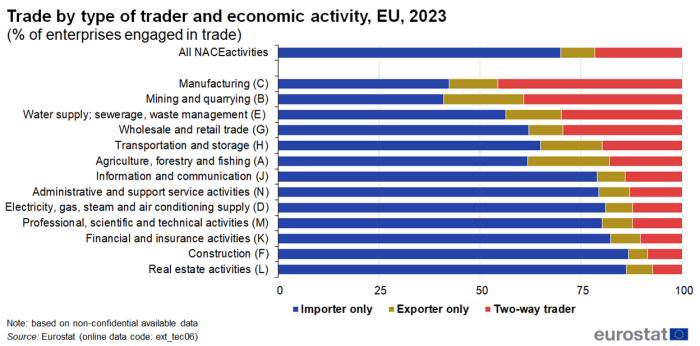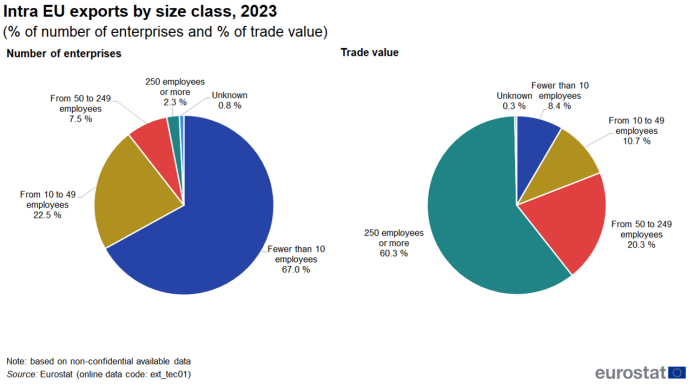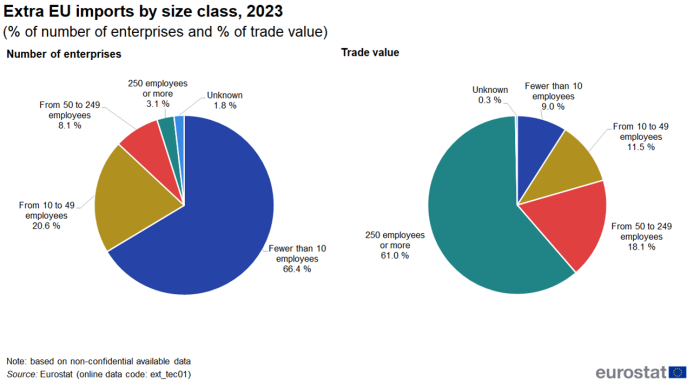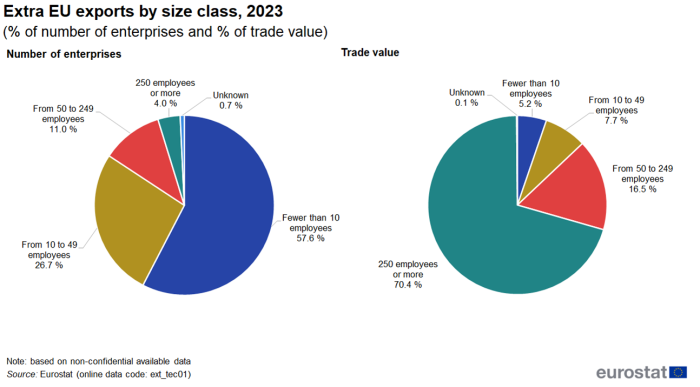Data extracted in June 2025
Planned article update: June 2026
Highlights
In 2023, 70% of the EU enterprises engaged in trade were importers only.
Over the last few decades, there has been a rapid expansion in the level of international trade in goods. Trade in goods is viewed as one of the most important drivers of globalisation as demonstrated by Globalisation patterns in EU trade and investment, an online Eurostat publication presenting a summary of recent European Union (EU) statistics on economic aspects of globalisation, focusing on patterns of EU trade and investment. Yet, aside from a range of studies on relatively large, foreign owned enterprises, little is published regarding the characteristics of enterprises trading across international borders - this subject is covered in more detail within this article.
Traditionally, international trade statistics have shown movements of goods between countries and by goods category, they have not provided explicit information as to the characteristics of those enterprises behind such trade flows. In a globalised world, this information is of particular interest to policymakers as they attempt to understand how economies are becoming increasingly interconnected.
Statistics on international trade in goods by enterprise characteristics
Statisticians have looked at using international trade in goods statistics in conjunction with business statistics to provide an enriched analysis of the characteristics of enterprises engaged in international trade, for example, providing information as to their economic activity, their size or the concentration of trade. This can help identify differences between enterprises that trade internationally and those that do not. This has been made possible by linking microdata concerning international trade with business register information. Note that only aggregated results are presented thereby protecting the confidential nature of this information.
The statistics used in this article were initially divided between enterprises which trade internationally and those enterprises which are active only within their domestic market as research has shown that international traders differ considerably from enterprises that operate solely within their domestic market. The group of international traders was then further subdivided into importers, exporters and two-way traders (enterprises which both imported and exported).
Trade by type of trader
Figure 1 presents aggregated information for the EU countries detailing the composition of those enterprises that were engaged in trade. In 2023, 70.0% of EU enterprises engaged in trade were only importers, while 21.7% were two-way traders, the remaining 8.3% were only exporters. Importers are of interest to policymakers insofar as they facilitate access to new goods and services that were otherwise not easily available, whereas exporters are of interest due to their potential for job creation (that may be linked to economic growth that results from expanding into new markets).
An analysis by NACE divisions reveals that there were considerable differences with respect to the make-up of those enterprises engaged in trade across different economic activities. Within the EU, the highest proportions of two-way traders were recorded for manufacturing activities. Whereas, for most services it was more commonplace to find that the largest proportion of enterprises engaged in trade were importers only.
Figure 2 compares the number of enterprises to the value of trade. It reveals that two-way traders accounted for the vast majority of total trade in value terms: across the EU, two-way traders accounted for 95.3% of all goods traded in 2023. This would tend to suggest that a high proportion of importers only and exporters only tend to trade with relatively few countries and/or relatively few (low value) transactions, whereas two-way traders were more inclined to have a larger number of transactions and a wider range of trade partners.
Trade by enterprises size class
Figures 3 to 6 how that a relatively high share of total trade value is generated by a small number of large traders.
In intra-EU imports small and medium sized enterprises (SMEs - enterprises with less than 250 employees) accounted for 98.2% of the number of enterprises but accounted for 46.0% of the value of imports while large enterprises (more than 250 employees) accounted for 1.1% of the number of enterprises but accounted for 53.6% of the value of imports.
In intra-EU exports SMEs accounted for 96.9% of the number of enterprises but accounted for 39.4% of the value of exports while large enterprises accounted for 2.3% of the number of enterprises but accounted for 60.3% of the value of exports.
In extra-EU imports SMEs accounted for 95.1% of the number of enterprises but accounted for 38.6% of the value of imports while large enterprises accounted for 3.1% of the number of enterprises but accounted for 61.0% of the value of imports.
In extra-EU exports SMEs accounted for 95.3% of the number of enterprises but accounted for 29.4% of the value of exports while large enterprises accounted for 4.0% of the number of enterprises but accounted for 70.4% of the value of exports.
Comparing the information from Figures 3 to 6, shows that large enterprises had higher shares in exports than in imports and higher shares in extra-EU trade than in intra-EU trade.
Trade by enterprise ownership
The final section of this article analyses the share of international trade by enterprise ownership, an area that is of considerable interest to policymakers when trying to establish the impact of globalisation on economic performance. When interpreting the figures below, readers should be aware that it was not possible to determine the type of ownership for all enterprises.
Across the EU, foreign owned enterprises accounted for 51.3% of the total value of extra-EU imports in 2023, which was approximately 4 percentage points (pp) higher than the share accounted for by domestically owned enterprises (47.0%). A large majority of the number extra-EU importers were domestically owned (86.1nbsp;%) while foreign owned extra-EU importers accounted for 8.3%
The situation was quite different for exports, as enterprises controlled by domestic owners accounted for 54.9% of the total value of extra-EU exports, which was approximately 11 pp higher than the share accounted for by foreign owned enterprises (44.0%). A large majority of the number extra-EU exporters were domestically owned (83.1%) while foreign owned extra-EU exporters accounted for 10.2%








